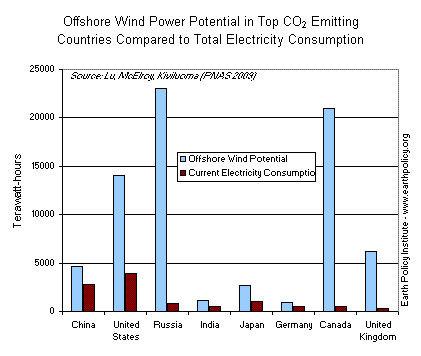 As the US counts the cost of offshore oil drilling Janet Larsen of the Earth Policy Institute has sensibly respondedwith a reminder of the advantages of offshore wind energy. Offshore drilling has tempered the rapid decline in US oil production which peaked in the early 1970s. But only somewhat and with increasing difficulty and apparently at a level of risk greater than credited until now.
As the US counts the cost of offshore oil drilling Janet Larsen of the Earth Policy Institute has sensibly respondedwith a reminder of the advantages of offshore wind energy. Offshore drilling has tempered the rapid decline in US oil production which peaked in the early 1970s. But only somewhat and with increasing difficulty and apparently at a level of risk greater than credited until now.
“We should leave oil before it leaves us” was the advice of Fatih Birol, chief economist at the International Energy Agency. Larsen points out that it’s not as if there aren’t other options. One is expanded public transport and better space for bicycles and pedestrians. That’s not an insignificant contribution to lowered use, though it’s not one that has any appeal for our Minister of Transport who is intent on starving public transport in favour of roadbuilding over the next few years. A second is the electrification of vehicles and powering them through renewable energy sources. Larsen points to the US Pacific Northwest National Laboratory estimates that the current electrical infrastructure could power over 80 percent of the US car fleet, relying largely on off-peak electricity as cars are charged at night. She notes that upgrading to a stronger, smarter, and interconnected national grid that taps into the country’s enormous wind, solar, and geothermal resources completes the transition. Here in New Zealand the positive possibilities of powering our entire car fleet from renewable energy sources have been canvassed with similar optimism.
Wind-sourced electricity has the potential to work particularly effectively in powering vehicles. The Edison pilot project in Denmark will aim at showing how:
“The basic idea is to charge the vehicles at night when the wind continues to blow, but when there is low demand for electricity. During the day, each vehicle will become a mobile electricity storage unit that can be plugged back in after the morning commute, potentially supplying energy back to the grid during times of peak demand, thus smoothing out energy distribution woes.
“Electricity charging stations powered by wind turbines will be installed in private homes as well as in corporate and public parking lots. Both fast-charging stations as well as battery swapping alternatives will be explored by the project.”
Back to Larsen’s article. A recent study published in the Proceedings of the National Academy of Sciences finds that the world’s top carbon emitters have enough wind energy potential to meet their current electricity needs many times over. When land-based sites are included, the total US potential from wind is estimated at 22 times current electricity use. For China the wind resource potential is 15 times greater than the country’s current electricity consumption, and for Russia, it is a staggering 170 times higher.
Offshore wind alone, Larsen points out, has the potential in the US to provide four times the nation’s current electricity use. Looking at only the offshore potential she provides a graph of the ten top CO2 emitting countries.

To date most of the offshore production has been in Europe, but China and Japan have begun developing offshore farms and it seems possible that the US will soon join them. The recent approval of the Cape Wind project off the coast of Massachusetts and other proposals under consideration point in that direction.
Wind energy is still much disputed, including here in New Zealand. This statement from the Wind Energy Association was issued in March in reply to what it saw as the failure of the Institute of Professional Engineers to understand the potential wind power offers. But for all the naysayers the industry is growing rapidly in many countries, including the US and China.
I liked Janet Larsen’s final paragraph:
“Unlike oil, wind is widely-distributed and clean; it does not spill or disrupt climate. It is also becoming increasingly cheap. With wind, we have a well that will not run dry.”
Tell that to Gerry Brownlee as we offer extended tax breaks for offshore oil exploration in New Zealand.

 This is a guest post by Phil Scadden, a regular commenter at Hot Topic (bio at the end of the post). Phil’s interested in energy issues, and has spent a considerable amount of his personal time developing an overview of New Zealand’s energy issues, inspired by the approach used by Cambridge physicist David MacKay in his recent book Sustainable Energy – without all the hot air. I’m very pleased to say that Phil is making his work available via Hot Topic (PDF
This is a guest post by Phil Scadden, a regular commenter at Hot Topic (bio at the end of the post). Phil’s interested in energy issues, and has spent a considerable amount of his personal time developing an overview of New Zealand’s energy issues, inspired by the approach used by Cambridge physicist David MacKay in his recent book Sustainable Energy – without all the hot air. I’m very pleased to say that Phil is making his work available via Hot Topic (PDF  An Italian olive grove and vineyard is on its way to becoming the world’s first carbon neutral farm (they claim).
An Italian olive grove and vineyard is on its way to becoming the world’s first carbon neutral farm (they claim). 